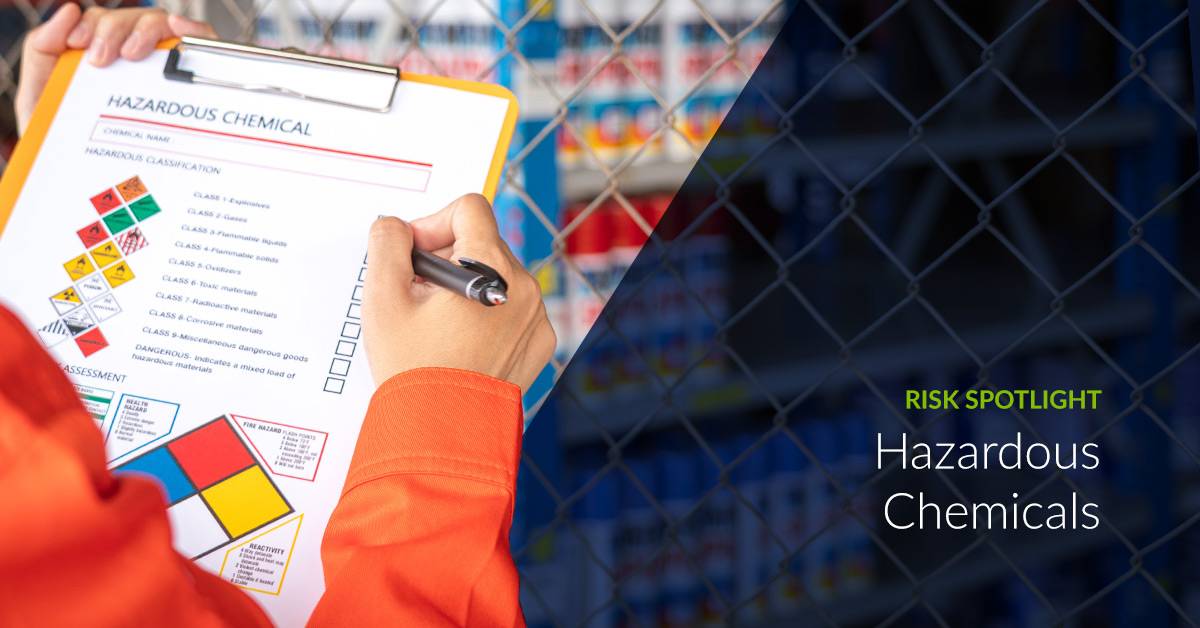What are Hazardous Chemicals?
Hazardous chemicals are substances that can pose significant risks to human health, safety, or the environment. These chemicals can be harmful when inhaled, ingested, or come into contact with the skin.
The key characteristic of hazardous chemicals is their potential to cause damage or injury in certain conditions, such as exposure through spills, leaks, or accidents.
Common hazardous chemicals found in workplaces
Many people don’t realise they are working with hazardous chemicals, which can pose a range of risks. You may be at risk if you come into direct contact with these substances or inhale their fumes while working.
- Cleaning Products (e.g., Bleach, Ammonia, and Disinfectants)
Often used in janitorial and maintenance work, these products can cause respiratory issues, skin irritation, and eye damage. Ammonia and bleach can also release toxic gases when mixed. - Solvents (e.g., Acetone, Toluene, Xylene)
Commonly used in manufacturing, painting, and cleaning, solvents are flammable and can cause headaches, dizziness, and long-term damage to the nervous system when inhaled. - Paints and Coatings
Many industrial and construction workers deal with paints, varnishes, and coatings that contain hazardous chemicals like lead, benzene, or toluene. These chemicals can cause respiratory issues, skin irritation, and neurological damage. - Pesticides and Herbicides
Used by pest technicians and landscaping trades, these chemicals are toxic and can cause a range of health issues from skin irritation to long-term neurological damage. - Dust (e.g., Silica Dust, Wood Dust)
Workers in construction, mining, and carpentry may be exposed to hazardous dusts. For example, silica dust can cause lung disease (silicosis), while wood dust is a known carcinogen.
How do I determine if the substance or chemical we are using is classed as hazardous or dangerous?
Check the packaging and labels
Hazardous chemicals must display clear labels with hazard symbols (such as skull and crossbones, exclamation marks, or flames), indicating risks like toxicity, flammability, or corrosion. Dangerous goods are required to be labelled according to the Australian Dangerous Goods Code (ADG Code). The label will typically feature a diamond-shaped symbol or pictogram that indicates the type of hazard (e.g., flammable, toxic, explosive).
Review the Safety Data Sheet (SDS)
The SDS will also indicate if the substance is classified as a dangerous good or hazardous chemical under Australian regulations. The SDS should be easily accessible and can be obtained from the manufacturer or your supplier.
Consult the Supplier or Manufacturer
If you’re unsure, you can contact the supplier or manufacturer of the substance directly to confirm whether it is classified as a hazardous chemical or dangerous good. They are legally required to provide this information and can supply you with the necessary documentation, such as the Safety Data Sheet (SDS) or labeling data.
Enhancing Safety and Compliance when handling Hazardous chemicals and/or Dangerous Goods
Hazardous chemicals can be extremely dangerous if mishandled, leading to accidents, workplace injuries, or even fatalities. Complying with safety regulations helps reduce the likelihood of such incidents by ensuring proper handling/use and training.
Recent developments in Cm3’s Hazardous Chemicals & Dangerous Goods Risk Review have led to significant advancements in both efficiency and safety. Notably, there has been a 75% reduction in the number of questions contractors need to respond to in this Risk Review, eliminating duplication and streamlining the review process.
The revised Risk Review also includes clearer, more precise criteria for vendors, ensuring that expectations are easily understood and aligned with safety standards. These changes simplify the process for vendors to obtain Cm3 Client Compliance by reducing the need to attach duplicate documents and minimising confusion.
Contractors who use, or whose subcontractors use, a substance or chemical classed as hazardous or dangerous, are encouraged to add this to their BRP.
Are you looking for a solution to manage safety and compliance of contractors conducting high-risk work on your sites?
Speak to a solutions expert to explore the range of detailed Risk Reviews on Cm3 that assess your vendors’ preparedness to manage safety risks.
